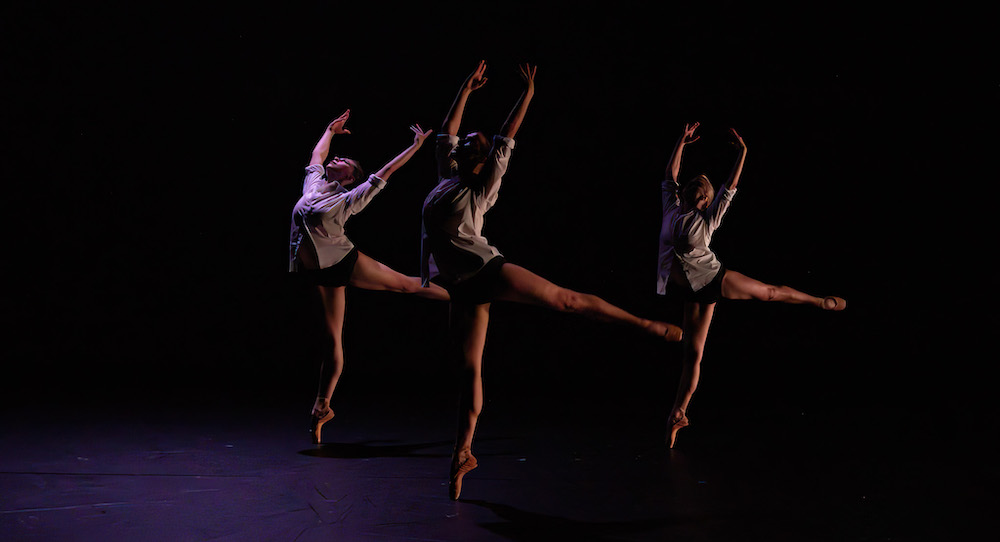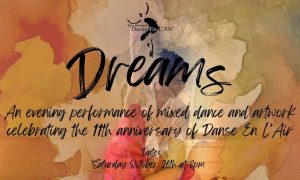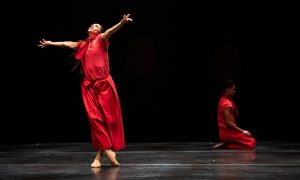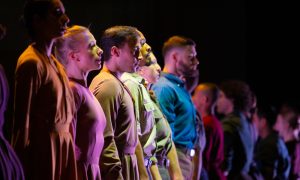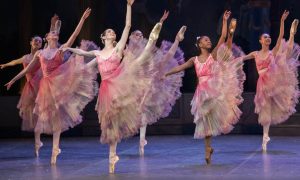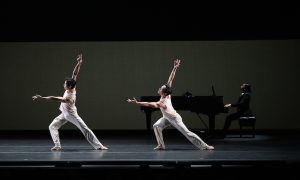Woodman Arts and Community Center, Moses Brown School, Providence, RI.
October 24, 2021.
Abstraction comes with compelling mystery; sometimes the answers are more exciting than the questions. Clear answers and meaning, on the other hand, have their own advantages. When it comes to art, both can draw as well as deter audience members.
Finding the balance of clear meaning and mysterious abstraction is never an easy task, yet Festival Ballet Providence achieved something like it with Continuing Points. The program was also a return to live performance in an indoor theater since COVID hit in March 2021 — a continuance, if an inflection point, of what the company was presenting before a global pandemic upended life as we knew it.
A pre-show film was one key way in which the company balanced clarity of meaning and the mystery of abstraction. In the film, each choreographer had a section to share a bit about their work: process, meaning, how the work illustrates parts of who they are as artists and as people, and more. Compelling rehearsal footage accompanied their mini-interviews, giving audience members a pleasing window into the process of creating concert dance.
This approach is a seemingly effective one, as it allows choreographers to create the wonderful mystery that dance can be while also not having to fear audience members being put off by not having a clear meaning to take away (not “getting it”) — and I don’t believe I’ve seen other companies use it. For a field engaged in important conversations about equity, access and sustainability with respect to live art, such approaches could be quite instructive and fruitful.
Annabelle Lopez Ochoa’s Returning Points (2006) kicked off the program. In a pre-show video, Lopez Ochoa explained how she likes to begin each work with a question — a sort of “what happens if…”, or, as one could interpret, oriented to a task or solving a problem. For this work that was working with all tall ballerinas on pointe shoes (a first for her with this work, Lopez Ochoa recounted), with a ballerino accompanying and partnering them.
Yet, I saw in the work something more universal and timeless than simply an investigation or problem-solving endeavor: light and dark, the yin and the yang, the sacred and the profane, the modern and the classic. A wonderful thing about art is that neither way of interpreting and experiencing the work is better or worse than the other, or definitively “right” or “wrong”.
Building this sense of sacred and profane was a score of modern electronica peppered with the formal, airy chanting of monks (by Arvo Part). Similarly imbuing yin and yang, light and dark were simply-cut black and white costumes. Dancers also moved in and out of shadows, shifting from apparitions to something ethereal and spiritual.
Movement choices also built contrast; lines of dancers moving in linear paths across the stage infused formalism while melty, more internally-felt movement conveyed individuality — and even rejection of conformity. Movement vocabulary stacked fresh contemporary shaping on a solid classical foundation.
The three ballerinas wore pointe shoes and seemed to embrace feminine softness and malleability, yet they were in no way the waifish, “damsels in distress” of once upon a time. At certain points, they pounded the tops of their pointe shoes in unison — which added an intriguing auditory layer but also stood as an assertion of their strength.
Lopez Ochoa’s question of what would happen with very tall ballerinas together on stage resulted in one thing for certain: their lines, made even longer by pointe shoes, seemed to have energy extending forever — beyond any binaries. Curvilinear shaping to the movement, of clear swim and swerve, reinforced that sense of strength and softness co-existing.
Toward the end, under a new purple hue in the lighting, the four dancers came together in tableau. As the shape breathed and evolved, it seemed to melt away any spectrum of opposites. Sometimes, the distance between the sacred and the profane is small or non-existent; life’s complex that way. Absent of any deeper meaning, the work was a rich feast of sensory interest in which any viewer could find something magical.
Artistic Curator Yury Yanowsky’s Finale investigated death and grief through two dancing bodies, a pared-down aesthetic and emotionally evocative movement vocabulary. Within the pre-show video, Yanowsky explained the theme of a journey through life into death — and also the experience of those left behind.
Aesthetically, low lighting and dark, unadorned costumes built an atmosphere of mystery and emptiness. That struck me as fascinating and meaningful in relation to the theme; no one can recount the experience of what happens after death, and one can’t really know the deep, often consuming experience of grieving a loved one unless they’ve been through it.
In the same way, movement in relation to the theme captured my heart and mind. The duet partners (Tara McCally and Alex Lantz) maintained physical contact for the entire piece. This made me think about how grief is a profound weight we carry, rooted in the love we had for the person to which we’ve had to forever say goodbye. Deep love like that stays with us, even becomes part of us. It’s shaped who we are. Getting even more spiritual and existential, one could also wonder if those who’ve passed on have a similar experience.
The hazy, mysteriously dreamy score (by Wilsen) plunged me deeper into thought, with lyrics speaking of “moments too soon, seconds too late” and “phantoms of sorts”. McCally and Lantz enhanced that mystery and haziness through malleability in their movement but also cultivated a clarity to their performance — a combination of qualities that kept my eyes transfixed even as my mind spun with those existential questions (questions humans have pondered for ages).
In an ending befitting the weighty concept, the pair slowly walked upstage as the lights and score slowly dimmed. Grief stays with us, just as these questions of life and death persist so long as humans do.
Next came Lia Cirio’s Sabali, a work full of ingenuity and various aesthetic qualities to enjoy. Cirio explained in the pre-show video that “sabali” roughly translates from Bambara as “patience”, and the work was her exploration of patience. Why do we, as people, find it so hard to enact and maintain it, for example? Cirio is a Boston Ballet principal dancer. The company’s versatility and broadness of stylistic interests, and how hard Cirio has worked and all that she has learned in that environment, was clear in the work.
The movement was quick, continuous and energetic — like a stream continuing to flow. That quality struck me as interesting in relation to Cirio’s stated theme for the work; one might even see the idea of patience and this freneticism as contradictory. Yet, thinking deeper, perhaps an attainable form of patience in this fast-paced world is to move with that stream gracefully and authentically — which the dancers certainly did. Brightly-colored costumes (by Jule Dancewear) and various upbeat scores reinforced those high-energy qualities.
Yet, at other points, tension through space and in dancing bodies illustrated the inner conflict we can feel in the quest for patience, and in those times when it escapes us. The mood lightened with a party of a section to end the piece: the dancers moving with brightness, lightness and joy. The score tempted me to get on my feet and groove.
Through all of these sections and qualities, Cirio’s serpentine, multifaceted and, at times, delightfully offbeat movement vocabulary distinguished her as a choreographer to watch for even bigger and better things.
The second act offered Paquita Suite, bringing brightness and distinguished pomp as only classical ballet can. Yanowsky, Leticia Guerrero and Christopher Anderson staged Joseph Mazilier’s choreography. Eugenia Zinovieva and Mamuka Kikalishvili joyfully ate up space in their pas de deux, balancing refinement and pure passion. A pas de trois (danced by Kailee Felix, Nina Yoshida and Kobe Atwood Courtney) was similarly polished but offered delightfully authentic honesty in characterization.
This act made clear to me, however, that the company’s contemporary work is stronger than its classical work. Yet, this classical work was nevertheless so thoroughly enjoyable that I certainly had nothing to complain about (and the company’s contemporary work is a high bar to meet!). And that of course doesn’t mean that the company should fully shift focus to contemporary work. Classical work can be unforgiving in its exactitude, and that’s the process — coming back again and again to reach for an unattainable perfection.
All of that aside, including both contemporary and classical work in the program can offer a little something to different sorts of audience members: those enjoying the mystery of abstraction and those preferring something beautiful and if with a meaning, not something to be assiduously teased apart and pondered.
Balance can be the name of the game in life, and art is no exception. Being thoughtful and investing a few additional resources is sometimes all that it takes to get there. Brava and thank you to Festival Ballet Providence for doing just that and presenting an extraordinary program, the first program back to a theater with audience members there to cherish all that it is.
By Kathryn Boland of Dance Informa.


